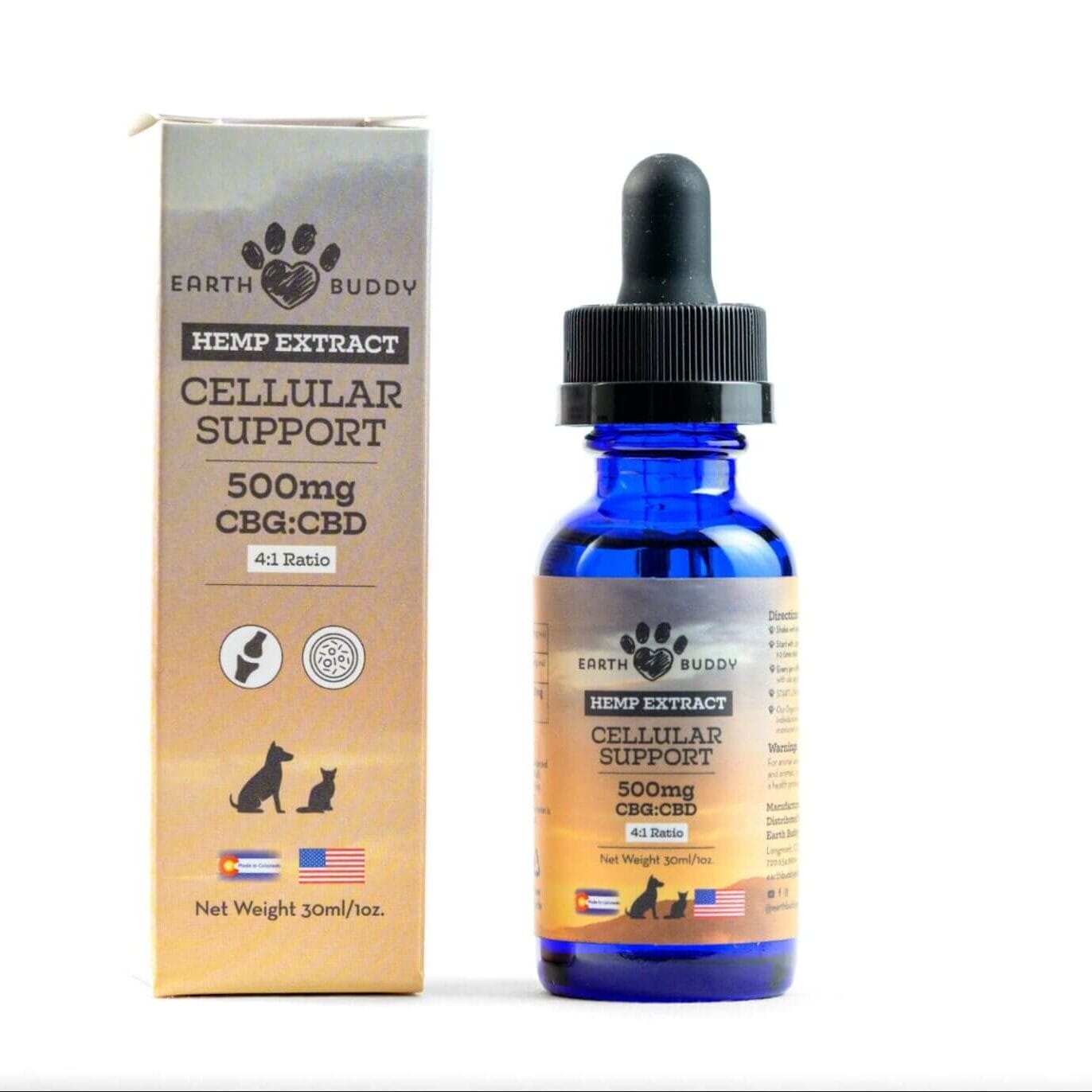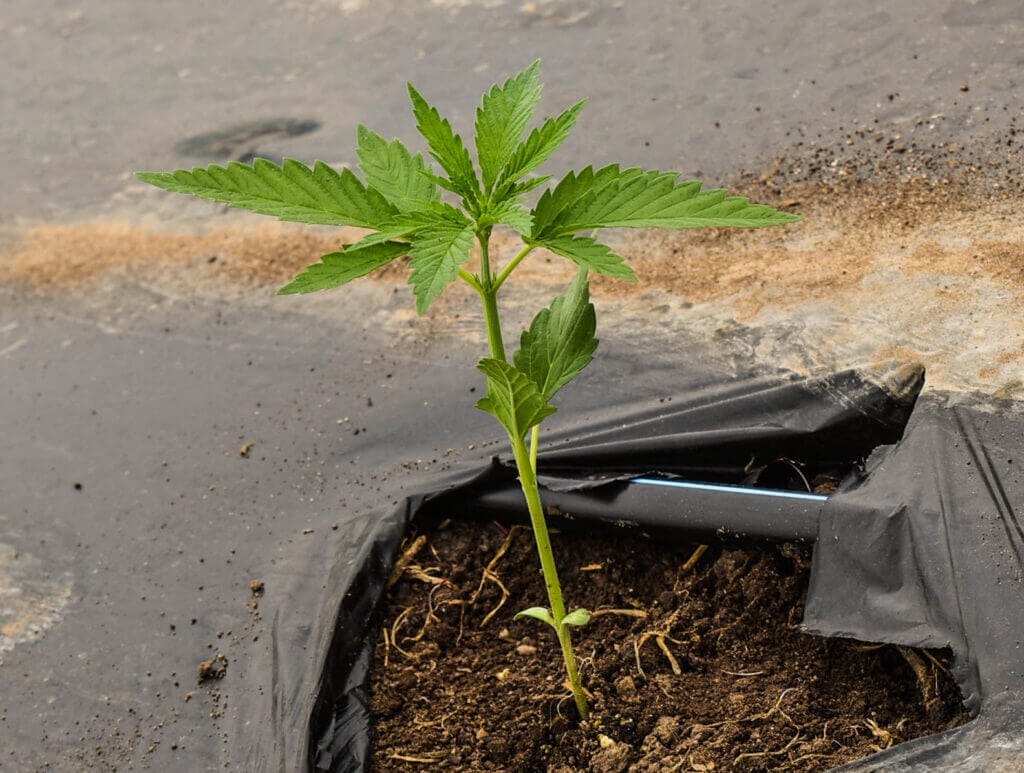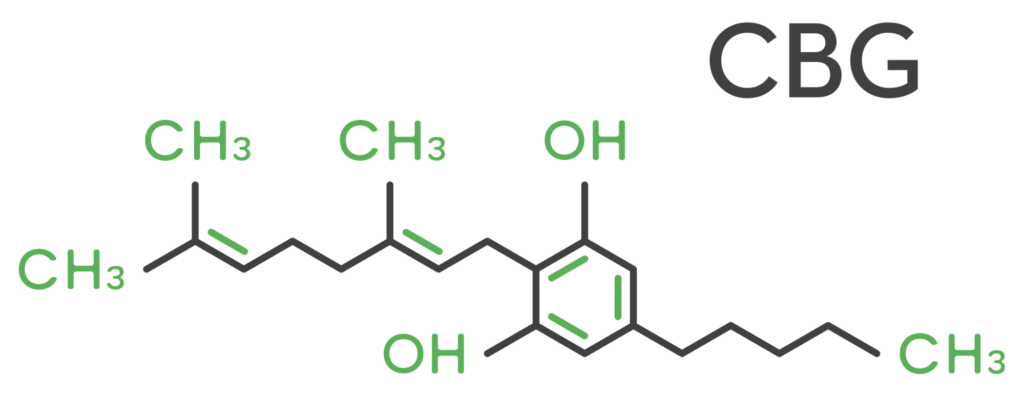Blog | CBD Oil Blog | Dogs
With Cats and Dogs, What is CBG Good For?
November 3, 2023
Written By: Earth Buddy Team

Cannabigerol, also known as CBG, is one of the many minor cannabinoids found in the cannabis plant. This is often one of the lesser-known cannabinoids, but due to its potential benefits, it is gaining traction in the pet space. In the past, CBD has been the primary subject of study, but researchers are now diving into the beneficial effects of other compounds. Now, what is CBG good for? Let’s take a look at what’s been discovered thus far.
CBG in Cannabis Plants
Within the cannabis plant, Cannabigerol (CBG) is a pivotal compound, though its concentration can vary greatly based on factors such as the plant’s age and specific strain. In the initial stages of a cannabis plant’s life cycle, it predominantly possesses Cannabigerolic acid (CBGa) – the precursor or foundational form of CBG.
Intriguingly, as these young cannabis plants grow and are exposed to sunlight, CBGa undergoes a transformation, giving rise to other cannabinoid precursors including Tetrahydrocannabinolic acid (THCa) and Cannabidiolic acid (CBDa). This is why CBG has been aptly termed the “stem cell” or “mother” cannabinoid, serving as the initial from which most other cannabinoids originate.
However, by the time cannabis plants fully matures, the CBG content is notably diminished, often constituting less than 1% of the plant’s total cannabinoid profile. In recent years, with advancements in cannabis cultivation techniques, strains with augmented CBG concentrations are being developed. Concurrently, scientific investigations and empirical observations are increasingly shedding light on the potential benefits linked to this notable cannabinoid.
Biologically Active Compounds in CBG: How CBD and CBG Intertwine With Other Compounds
CBG is considered a precursor to other major cannabinoids that cannabis plants produce because, during the plant’s growth, CBG is converted into these other cannabinoids. Here’s a brief overview of CBG and the biologically active compounds associated with it:
CBG itself (cannabigerol)
CBG interacts with both CB1 and CB2 receptors in the brain. Although its binding strength or affinity to these receptors may not be as robust as some other cannabinoids, CBG has a distinct role to play.
Instead of merely binding to these receptors, CBG is thought to function as a sort of gatekeeper. It has the potential to obstruct other compounds from attaching to the receptors, thereby regulating their effects. This characteristic implies that CBG can act as a buffer, ensuring that no single compound overly dominates the receptors.
This regulatory role of CBG underscores its potential benefits, as it could enhance or modify the effects of other cannabinoids and play a balancing act within the endocannabinoid system.
CBGa (Cannabigerolic Acid)
CBGa serves as the foundational compound from which the acid precursors of other major cannabinoids like THC, CBD, and CBC are derived.
As the cannabis plant undergoes its growth and developmental phases, enzymes within the plant act upon CBGa, directing it to transform into either THCa (Tetrahydrocannabinolic acid), CBDa (Cannabidiolic acid), or CBCa (Cannabichromenic acid). This is a fascinating and vital aspect of cannabis botany because the ratios and presence of these acids can influence the plant’s overall cannabinoid profile and, subsequently, its potential benefits.
The story doesn’t end with these acidic forms. When the cannabis plant is exposed to heat, a process called decarboxylation occurs. This heating process can be natural, as when the plant is dried, or it can be deliberate. During decarboxylation, the acidic forms of cannabinoids shed a carboxyl group, converting into their more active, neutral forms. For instance, THCa becomes THC, CBDa becomes CBD, and so on.
Terpenes
Cannabigerol (CBG), as with its cannabinoid cousins, doesn’t exist in isolation within the cannabis plant. Alongside CBG, a rich and diverse array of terpenes can be found, each imparting its unique aroma to different strains of cannabis. These terpenes, however, aren’t merely about fragrance; they’re powerful compounds, and have been studied for their potential effects across a range of applications.
In the context of the cannabis plant, terpenes have been shown to help maintain optimal healthn. For instance, limonene, with its citrusy scent, has been studied for its ability to help maintain a balanced disposition. Myrcene, another common terpene, exudes an earthy aroma and could provide help for restless animals.
The truly fascinating dimension emerges when cannabinoids and terpenes coexist. This harmonious interaction, termed the entourage effect, suggests that the combined influence of cannabinoids like CBG, CBD, or THC and terpenes can be greater than the sum of their individual effects.
Flavonoids
Flavonoids, naturally occurring groups of phytonutrients, can be found in nearly all fruits, vegetables, and, of course, the cannabis plant. These compounds serve a critical role in determining the vivid colors of many plants, from the brilliant reds of strawberries to the deep purples of blueberries.
Flavonoids in various plants have been linked to numerous benefits, including helping maintain a normal inflammatory response, helping eliminate free radicals associated with the aging process, and even supporting normal cell function. Their potency is believed to derive from their ability to help decrease oxidative damage, supporting and promoting long-term health.
Within the context of the cannabis plant, flavonoids represent around 10% of the known compounds. Specific flavonoids, like cannflavins A and B, are unique to cannabis and have shown potential in aiding with occasional discomfort. Their synergy with cannabinoids is of particular interest. When flavonoids interact with cannabinoids like CBG, CBD, or THC, they may enhance their effects, in a manner similar to the way terpenes do.
How CBG Works in the Body
CBG, or cannabigerol, stands out within the realm of cannabinoids, primarily due to its distinctive mechanism of action. The mammalian body (humans, dogs, cats, etc) contains an intricate system known as the endocannabinoid system (ECS). Within the ECS, there are two primary types of receptors: CB1 and CB2. CB1 receptors are predominantly located in the brain and central nervous system whereas CBD receptors are more widespread with most being found in the peripheral organs.
What makes CBG remarkable is its affinity for both these receptor types. While certain cannabinoids may preferentially bind to one receptor over the other, CBG demonstrates an ability to interact with both. This dual interaction can potentially amplify its impact.
Central to this process is anandamide, a naturally occurring neurotransmitter sometimes dubbed the “bliss molecule.” Anandamide plays a crucial role in helping maintain calmness, supporting weight loss and a healthy appetite, and providing help for restless animals, among other benefits. CBG’s interaction with the ECS receptors can enhance the function and availability of anandamide, thus modulating its effects and promoting homeostasis.
Given this unique interplay of CBG with the body’s receptors and its influence on crucial neurotransmitters, it’s essential to consider its potential benefits holistically. When browsing through the myriad of potential benefits CBG offers, it’s crucial to have this foundational understanding. The true power of CBG might lie in its ability to bridge the gap between the brain and the body due to working with both types of receptors.
What is CBG Good For and How Does It Work
Unlike cannabinoids like CBD or THC, CBG interacts directly with the endocannabinoid system by binding specifically to both CB1 and CB2 receptors. This direct interaction facilitates a more effective delivery of CBG’s benefits to dogs when provided with a high-quality full-spectrum hemp extract or tinctures specifically developed with high concentrations of CBG, like Earth Buddy’s Cellular Support product. Now, let’s dive into the main question, “what is CBG good for?”
CBG Promotes Nerve Health
CBG can play a key role in maintaining and supporting a healthy nervous system. Its ability to interact directly with CB1 and CB2 receptors, which are predominantly found in the brain and throughout the nervous system, assists in supporting normal brain and nerve function. This, in turn, promotes normal, healthy brain activity and supports normal, balanced behavior.
CBG To Balance Mood
The endocannabinoid system (ECS) plays a crucial role in enhancing brain function by influencing neurotransmitter systems and brain regions involved in emotional processing. CBG interacts with this system by binding to CB1 and CB2 receptors, which are prevalent in the central and peripheral nervous systems, respectively.
CBG can influence the levels of neurotransmitters like serotonin and dopamine, which play key roles in helping animals maintain a normal and relaxed disposition. By modulating the release of these neurotransmitters, the effects of CBG may include supportiing normal emotional balance. Also, by supporting normal brain and nerve function, this compound helps maintain a normal disposition and alertness.
CBG For Immune Health
CBG can have a positive effect on a dog’s immune system by promoting normal inflammatory responses. Since the immune system often regulates the inflammatory responses in the body, CBG has shown potential for modulating healthy responses as well.
CBG engages the endocannabinoid system (ECS), which plays a vital role in regulating the immune system. CBG can activate cannabinoid receptors in the ECS, including CB1, CB2, and other peripheral receptors, and support immune system function.
Also, due to the relationship between the endocannabinoid system and the central nervous system (CNS), CBG may promote immune enhancing effects within the CNS.
CBG For Bladder Health
CBG appears to help maintain normal function of the urinary tract, which is essential for helping normalize bladder muscle function. By supporting normal bladder function, CBG may help normalize bladder muscle function and promote optimal urinary tract health and function.
Bladder health may also be improved by promoting normal inflammatory pathways. This could support normal renal function and health and suppors healthy waste elimination. This effect is believed to be due to CBG’s interaction with the endocannabinoid system, which can affect the processes within the urinary tract.
CBG For Digestive Health
The digestive system of dogs and cats houses a rich and diverse community of microorganisms, commonly referred to as the gut microbiota. This intricate ecosystem consists of a delicate balance between beneficial and potentially harmful bacteria. These microorganisms play a large role in the overall health of our pets.
A balanced gut microbiota helps maintain a healthy intestinal tract. As such, understanding and maintaining this balance is essential for supporting and promoting long-term health.
CBG’s interaction with the endocannabinoid system, particularly with the CB1 and CB2 cannabinoid receptors, is crucial. The ECS is integral to helping support healthy GI function, and the CBG’s interaction may help support proper digestion and bowel health.
CBG For Ocular Health
Cannabinoid receptors are abundantly present in eye tissues, suggesting that the endocannabinoid system might have a significant role in promoting ocular health. One of the most discussed benefits of CBG for ocular health is its potential to help maintain ocular integrity and structure.
CBG may also benefit ocular health by providing antioxidant support, which helps maintain normal eye function. Antioxidants have been shown to aid in the elimination of unstable oxygen molecules called free radicals. This helps eliminate free radicals associated with the aging process, which is why CBG is often recommended for dogs seven years of age or older to support and maintain proper body functions and an overall good quality of life.
CBG for Cognitive Health
CBG can activate two types of neuroreceptors that help maintain the general health of all ages and breeds. By binding with alpha-2 receptors, CBG influences the parasympathetic nervous system, which can support normal blood pressure and promote a sense of relaxation and mental alertness without drowsiness.
Acetylcholinesterase is an enzyme responsible for breaking down acetylcholine, a neurotransmitter crucial for helping support cognitive function. By inhibiting this enzyme, CBG promotes acetylcholine levels, which could support normal nerve conduction and memory recall.
More Research Will Continue to Shed Light
The potential health benefits of CBG (cannabigerol) for pets are an area of growing interest in the scientific community. Although preliminary studies and anecdotal evidence suggest that CBG shows promise with various health benefits to our furry friends, a comprehensive understanding remains on the horizon. The current body of research is still in its infancy and more research is needed to learn more about this compound.
Earth Buddy Pet Supplements With CBG for Dogs & Cats
Earth Buddy’s Cellular Support tincture contains high amounts of CBG extract and low CBD extract at a 4:1 ratio. To achieve the best results with CBD and CBG for dogs and cats, Earth Buddy has developed this tincture from new hemp plant varieties grown on a small farm in Colorado, that produce high amounts of CBG.
Organic MCT oil, from coconuts, is added to assist in the digestion and absorption of the compounds found in the tincture. If you do purchase this tincture combining CBD and CBG, start low and go slow. As a general guideline, start with .25mL per 20 lbs of body weight one or two times daily. For the lab results, click here.
Earth Buddy Maxx Life Glutathione capsules contain our revolutionary blend called the Hemp Essence Trinity of CBD, CBDa, and CBG for dogs and cats in Kief form along with encapsulated glutathione to support pet’s liver detoxification, overall immunity, and longevity. Maxx Life Glutathione comes in capsule form and also contains aminos and other flavonoids, vitamins and minerals. Maxx Life capsules can be opened and powder can mix into a food or a light snack 1-2 times daily depending on the size of your pet.
Benefits of Earth Buddy CBG for Dogs & Cats:
- Calms the nervous system and musculoskeletal stress
- Promotes healthy inflammatory responses associated with irritable bowels
- Relaxes tension from tremors or shaking
- Enhances immune cells in pets with weaker immune function
- Great for older pets who do not need heavy sedation, but more relaxation
For further reading, we recommend:
- https://pubmed.ncbi.nlm.nih.gov/23415610/
- https://www.ncbi.nlm.nih.gov/pmc/articles/PMC5333598/
- https://www.ncbi.nlm.nih.gov/pmc/articles/PMC9666035/
- https://www.ncbi.nlm.nih.gov/pmc/articles/PMC1772142/
- https://pubmed.ncbi.nlm.nih.gov/19112869/
- https://www.liebertpub.com/doi/10.1089/can.2021.0058
- https://www.ncbi.nlm.nih.gov/pmc/articles/PMC8266561/
- https://www.ncbi.nlm.nih.gov/pmc/articles/PMC7120914/
- https://www.ncbi.nlm.nih.gov/pmc/articles/PMC7763918/
- https://www.ncbi.nlm.nih.gov/pmc/articles/PMC8778347/
- https://jpet.aspetjournals.org/content/376/2/204
You Might Also Enjoy
Reactive dog barking may sound intimidating, but it’s important to differentiate it from dog aggression.…
Your dog’s skin is their largest organ making dog skin care a crucial part of…
Like us, our dogs, and other mammalian species, cats have an endocannabinoid system. This system…







